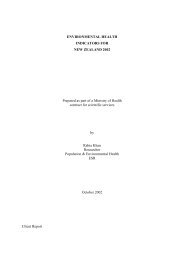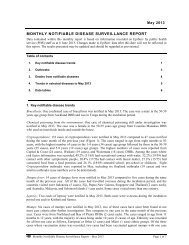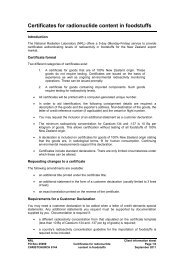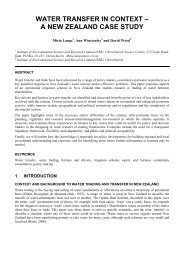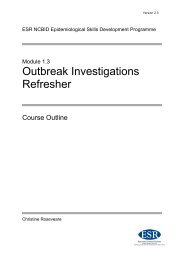2. METHODS2.1 Surveillance methodsIn this report, data for 2009 and <strong>2010</strong> is based on IPD case notifications supplemented withserotype and antimicrobial susceptibility data from the laboratory-based surveillance of<strong>in</strong>vasive S. pneumoniae isolates. Data for earlier years is from ESR‟s national laboratorybasedsurveillance of IPD.S<strong>in</strong>ce 17 October 2008, IPD has been notifiable to medical officers of health under the HealthAct 1956. Data on each case is entered at public health units (PHUs), via a secure web-basedportal, onto a computerised database (EpiSurv). The notification data is collated andanalysed on behalf of the M<strong>in</strong>istry of Health by ESR.For the national laboratory-based surveillance of IPD, diagnostic microbiology laboratories <strong>in</strong><strong>New</strong> <strong>Zealand</strong> are requested to refer all <strong>in</strong>vasive isolates of S. pneumoniae [ie, isolates fromcerebrosp<strong>in</strong>al fluid (CSF), blood or other normally sterile site] to ESR. In addition and lessfrequently, laboratories refer sterile site specimens to ESR to test for the presence ofpneumococcal DNA by PCR. At ESR all <strong>in</strong>vasive isolates are serotyped and tested forsusceptibility to a range of antibiotics (see Section 2.2).The notification data <strong>in</strong> this report is based on the <strong>in</strong>formation recorded on EpiSurv as at17 February 2011. Any changes made to EpiSurv data by PHU staff after this date are notreflected <strong>in</strong> this report. Serotype and antimicrobial susceptibility data for <strong>in</strong>vasive isolateswas matched with the relevant case notification.Except for disease rates by ethnicity and deprivation <strong>in</strong>dex, mid-year <strong>New</strong> <strong>Zealand</strong>population estimates were used to calculate <strong>in</strong>cidence rates. The 2006 census population datawas used to calculate ethnicity-specific IPD rates, and a prioritised approach was used withthe order of prioritisation as: Māori, Pacific Peoples, Other (other groups except European),and European. 8 Incidence rates are not presented for categories where there were
Data analyses were performed with SAS software v.9.1.3 (SAS Institute Inc, Cary, NC,USA). The chi-square test or Fisher‟s exact test, as appropriate, were used to determ<strong>in</strong>e thesignificance of any observed differences. L<strong>in</strong>ear regression was used to calculate thesignificance and direction of time trends. An associated P value of 0.05 was used to identifywhether a difference or trend was significant.2.2 Laboratory methodsDetection of pneumococcal DNA <strong>in</strong> cl<strong>in</strong>ical specimens: The presence of pneumococcalDNA <strong>in</strong> cl<strong>in</strong>ical specimens is detected by polymerase cha<strong>in</strong> reaction (PCR).Stra<strong>in</strong> typ<strong>in</strong>g: S. pneumoniae isolates are serotyped by the capsular antigen reaction(Neufeld test) us<strong>in</strong>g the Danish system of nomenclature and sera obta<strong>in</strong>ed from the StatensSerum Institut. 9 Methods have not been established at ESR to identify the stra<strong>in</strong> type whenonly pneumococcal DNA, rather than an isolate, is available. Therefore, the serotype canonly be determ<strong>in</strong>ed for culture-positive IPD cases.Antimicrobial susceptibility test<strong>in</strong>g: The penicill<strong>in</strong> and cefotaxime susceptibilities ofS. pneumoniae isolates are determ<strong>in</strong>ed by Etest (BioMerieux, France), us<strong>in</strong>g Mueller-H<strong>in</strong>tonagar with 5% sheep blood and <strong>in</strong>cubation for 20-24 hours <strong>in</strong> 5% CO 2 . Chloramphenicol,cl<strong>in</strong>damyc<strong>in</strong>, co-trimoxazole, erythromyc<strong>in</strong>, moxifloxac<strong>in</strong>, rifampic<strong>in</strong>, tetracycl<strong>in</strong>e andvancomyc<strong>in</strong> susceptibilities are determ<strong>in</strong>ed by the Cl<strong>in</strong>ical and Laboratory StandardsInstitute‟s (CLSI‟s) disc susceptibility test<strong>in</strong>g method. 10 Inducible cl<strong>in</strong>damyc<strong>in</strong> resistance isdetected by the D-zone test. 11 All m<strong>in</strong>imum <strong>in</strong>hibitory concentrations (MICs) and zone of<strong>in</strong>hibition diameters were <strong>in</strong>terpreted accord<strong>in</strong>g to the <strong>2010</strong> CLSI standards. 11In this report, the penicill<strong>in</strong> <strong>in</strong>terpretive standards, which were redef<strong>in</strong>ed <strong>in</strong> 2008, have beenretrospectively applied to historical MIC data so that time trends are comparable. Also, <strong>in</strong>this report, when associations between penicill<strong>in</strong> or cefotaxime resistance and patientdemographics, geographical distribution or serotypes are made, the men<strong>in</strong>gitis <strong>in</strong>terpretivestandards have been used.Multidrug resistance is def<strong>in</strong>ed as resistance to three antibiotics <strong>in</strong> addition to penicill<strong>in</strong>. Forthe purposes of this def<strong>in</strong>ition, the men<strong>in</strong>gitis <strong>in</strong>terpretive standards were used for bothpenicill<strong>in</strong> and cefotaxime.2.3 Case def<strong>in</strong>itionA case of IPD is def<strong>in</strong>ed as:1 the isolation of S. pneumoniae from CSF, blood or other normally sterile site; or2 the detection by nucleic acid amplification test of pneumococcal DNA <strong>in</strong> CSF, blood orother normally sterile site; or3 a positive newer-generation S. pneumoniae antigen test (ie, B<strong>in</strong>ax NOW) on CSF.<strong>Invasive</strong> pneumococcal disease 3 September 2011<strong>in</strong> NZ, <strong>2010</strong>




